One such artist is Yinka Shonibare, an artist born in Nigeria who lives and works in London. His series "Diary of a Victorian Dandy" features himself as the lead character of a series of images meant to show scenes of life in 19th century upper-class Britain, and they are loosely based on a series of etchings by Thomas Hogarth entitled "The Rake's Progress."
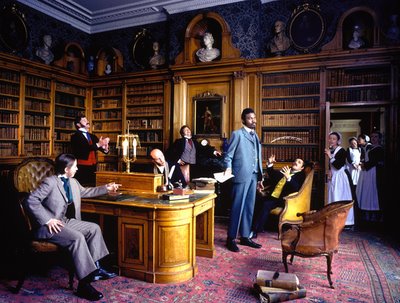 "Dairy of a Victorian Dandy, 14.00"
"Dairy of a Victorian Dandy, 14.00"The titles of Yonibare's photographs indicate the time of day they are meant to "illustrate."
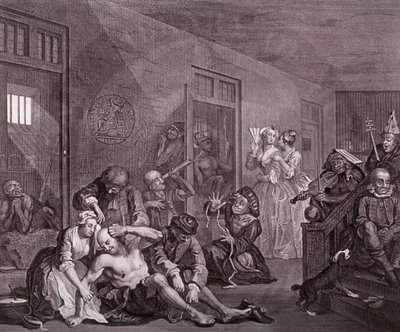 William Hogarth, "The Rake's Progress, Plate 8", 1735
William Hogarth, "The Rake's Progress, Plate 8", 1735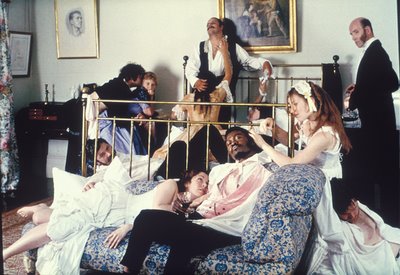 "Dairy of a Victorian Dandy, 3.00"
"Dairy of a Victorian Dandy, 3.00"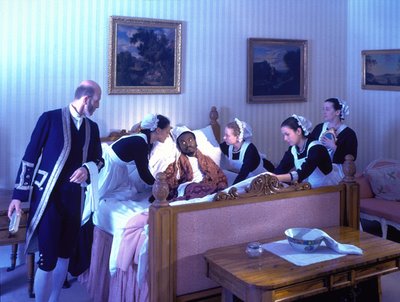 "Dairy of a Victorian Dandy, 11.00"
"Dairy of a Victorian Dandy, 11.00"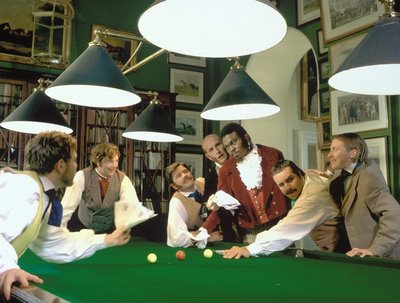
"Dairy of a Victorian Dandy, 17.00"
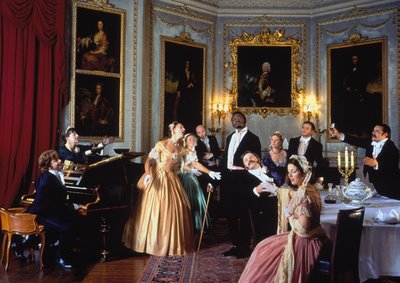 "Dairy of a Victorian Dandy, 21.00"
"Dairy of a Victorian Dandy, 21.00""Diary of a Victorian Dandy" was a collision of performance and photography reflecting the nation's popular taste for the period costume drama and nostalgia for a utopian past at the heart of 'little' England. The production was shot on location over a period of three days in the opulent and sumptuous environment of a stately home in Hertfordshire. The artist Yinka Shonibare is the central character of the dandy and orchestrates an ensemble of professional actors, a make-up artist, a stylist, a photographer and a director. Behind the superficiality and self-satisfaction of Shonibare's Dandy lies a deeper social resonance. The work is a powerful parody of the artist's own life as a creative black British man living with a physical disability in contemporary Britain. He alludes to a black aspirational designer generation, the contradictory social codes implied in the conspicuous sartorial elegance of figures such as Chris Eubank and the keeping-up-appearances mentality of the contemporary British 'dude' scene.
The artist's imposing physical presence--he is the largest man and the only black man present in the photographs--underscores his role as the central character in each tableau. Whether he plays the rogue/hustler/provocateur, as in the billiard-room scene, Diary of a Victorian Dandy (17:00 hours), or the celebrated social lion, as in Diary of a Victorian Dandy (21:00 hours), Shonibare draws attention to the political, racial and sexual tensions that underlie these sumptuously constituted visual fictions. The episodes are based on any number of British genre paintings as well as on Hogarth's The Rake's Progress. Yet they convey Shonibare's own agonistic fantasies about private and institutional power. The images imply that although the artist may assume the role of Insider Hero or glamorous Man of Mystery, he is destined, because of race, to remain perpetually Other, even in his own imaginings.

12 comments:
When looking at these images, I can't help but feel uneasy about them. The viewer sees a single african-american man partaking in what would have been a white male dominated society, He is surrounded by white men and women as their racial and economic equal. As the artist points out, he is partaking in these activities yet bound by race, he does not become anything more. Unfortunatly, up until recently, we have regarded those with different skin color below the the white male. I think the artist is trying to stir the viewer up to deal with the prejudice. Maybe the artist is trying to make us face the stereotype that we as a culture assign to people who are different than us.
I would have to agree with Laura. When I look at the images of "Dairy of a Victorian Dandy" the first thing I see is the black man presented in the images. Really that is where all my focus goes too. I am not looking at the people in the image because that one man has stolen the picture, everything else seems like it is just the black man's background. He is the focus of the picture
(continued) I belive that the photographer knew what he was doing when he centered the black man in the images. I agree that the artist wants us to deal with prejudice where ever it might be.
Brandi Ashlock
I don't feel uneasy when I look at these - delighted, really. I find these photographs to be comical. Maybe it's the title of the series... or more specifically, the word "Dandy". Or maybe it's the swooning of the women near Shonibare, or the way men reach out towards him. These photographs have to do with race and role-play, but in a very light-hearted manner.
I don't feel like there's much of a narrative here except for a simple "what if..". I think viewers develop the narrative themselves. What I mean is that the photo provieds a premise, and viewers can expand on that premise. Sometimes, observers can play minimal roles in interpretation and narrative development, but this piece offers a lot to think about - "How would this guy be treated at the annual ball?", "does he take a carriage to and from town?", "is he really wealthy, or is the whole thing a hoax?".
I agree that Shonibare is the focal point. His skin color is factor, but so is the use of line. In "19:00" for instance, arms are diagnol, pointing at Shonibare. If it's not arms, then it's torso positioning (lady to his immediate left). These "lines" help activate the space in between themselves and the artist. This weaves the photo's different elements together.
Compositionally, it's nice too. The photograph is asymmetrically arranged, but still evenly weighted. Shonibare isn't centered perfectly, he's on the right side. The photograph's right side is dense because of the lady in its foreground, but then is evenly waited by the red curtain on the left.
Well, when I look at the photographs I can't help and wonder what is this person doing for a leaving that he can spend is day doing nothing but entertain. I imagine himself being a Lord and therefore wealthy but then again the next thing that comes to mind he is a black man and back to the time the photograph is portraying black people were not wealthy or part of the high society. I find this photographs very charming. Instead of having the white male being the main focus we have a black one a very big contrast.
Oralia Gonzalez
First of all I think it's worth pointing out that the black man in the photographs _is_ the artist and is fully aware of the position he is putting himself in and the image he is trying to portray.
That said, before I read the article I glanced over the pictures and I have to say that I honestly didn't think about the racial desparities. Maybe it's a sign of the times or maybe it's just my own personal lack of attention to details but I just didn't catch it. To me, I just saw different portaits of different scenarios of the time period they are set in. However, one of the recurring themes that I see as I look through the pictures is friendship. I see friends who've all had waaay too much to drink, friends rallying around their sick companion, friends competeing over a game of pool, and friends just hanging out listening to good music.
-Zach Phillips
He looks as if hes trying to recreate history. His images show scenes that would never have been possible in that age and that particular environment. It may be portraying the hopes and dreams of a black man back then. It may show that he believes a black man should be given a more superior ranking in society. It may be trying to get society to notice the black man more because in the photos, he is the center of attention. There are so many messages that this picture might be trying to tell us and I've only named a few.
I am a huge fan of these photographs!!! They are hilarious to me. I would definitely hang these. When I look at these, I can tell the photographer has a sense of humor. The photographs remind me of things my friends and I would do. I think it would be a blast to dress up like this and recreate some of these pictures!
i really like these photographs because they are very funny, but i did not take notice that the main character was a black man. After reading the article though, i can understand better what the aritst is doing and they become more than just funny images, they make me think about social inequalites that are still in place today.
There is really nothing funnier than a joke about racism. I absolutely love the verbal jokes but to actually see it on a photograph, that an entirely different way of making me laugh. having that humor actually does help out. It draws attention so more people would be looking at your artwork. Nonetheless, they are great photos, (technically and conceptually)
I love these images. To me, there is an underlying comical aspect of each. During this time period, you would have hardly ever seen a black man portrayed in such instances. In fact, the only thing you might have seen him portrayed as would be a slave figure during this time period. But, rather than not only being IN the photograph, he is the main element. He is the focus of each picture, with all of these other memeber relinquishing in his delight. Another aspect I admire about the photographer in this is thinking how much time and effort went into the photoshoot. Costumes, backgrounds, models, everything is difficult to coordinate together. But it seems it was done so flawlessly, by the success of the photographs.
These pictures are quite humorous. The main character of this "story" seems like these scenes are commonplace for him when we know that is was quite contrary to how it really was. He also seems like he owns all of the settings, like everyone wants to be with him and that they envy him.
Post a Comment